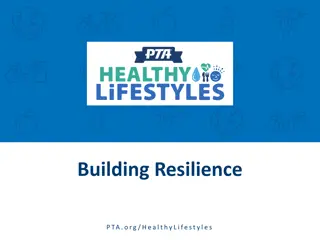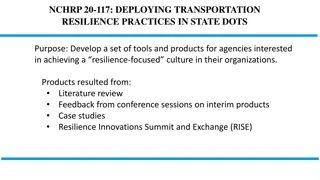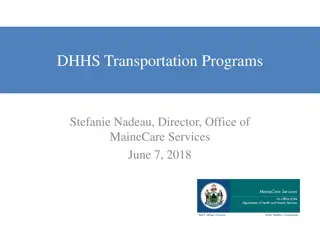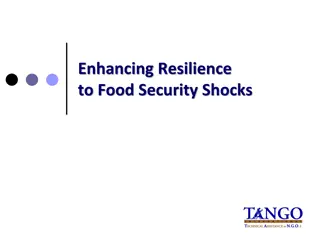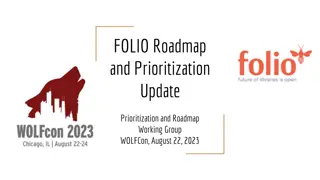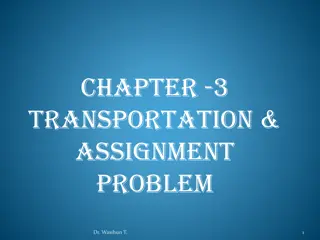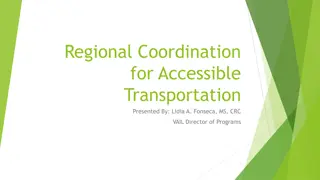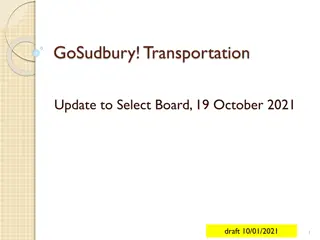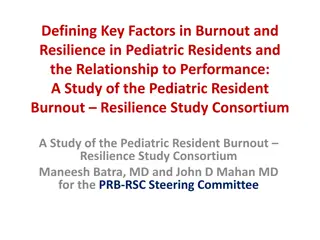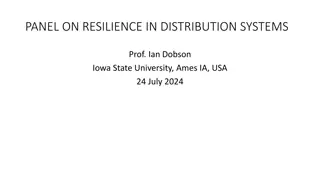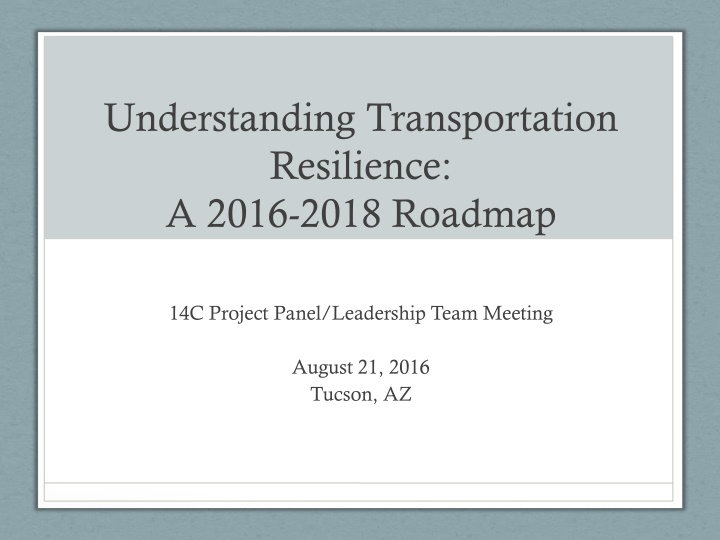
Transportation Resilience Roadmap & Strategies
The transportation system's ability to recover from disasters and disruptions is crucial for economic revival. Explore the concept of resilience in transportation through discussions on defining resilience, faces of resilience, and dimensions of resilience, focusing on planning, response, recovery, and adaptation to adverse events.
Download Presentation

Please find below an Image/Link to download the presentation.
The content on the website is provided AS IS for your information and personal use only. It may not be sold, licensed, or shared on other websites without obtaining consent from the author. If you encounter any issues during the download, it is possible that the publisher has removed the file from their server.
You are allowed to download the files provided on this website for personal or commercial use, subject to the condition that they are used lawfully. All files are the property of their respective owners.
The content on the website is provided AS IS for your information and personal use only. It may not be sold, licensed, or shared on other websites without obtaining consent from the author.
E N D
Presentation Transcript
Understanding Transportation Resilience: A 2016-2018 Roadmap 14C Project Panel/Leadership Team Meeting August 21, 2016 Tucson, AZ
Discussion Roadmap Introduction Background Defining Resilience Faces of Transportation System Resilience Resilience Strategies The SCOTSEM 2016-2018 Resilience Research Program 2 August 2016
Introduction The transportation system is a complex network of infrastructure, vehicles, power sources, communications, and human capital. When we speak of resilience in the transportation sense, we mean the ability of the transportation system to recover and regain functionality after a major disruption or disaster. AASHTO SCOR, 2016 [T]he performance of the transportation system is neither reliable nor resilient, yet transportation s role in economic revival and in global economic competition has never been more important. TRB, 2013 A major performance issue across all modes is the inadequacy of preparation for natural and human-made disasters AASHTO SCOR, 2016 3 August 2016
Background Concept of RESILIENCE as applied to Transportation was introduced 20 years ago Gained urgency and traction after 2011 as it related to TRANSPORTATION SECURITY Original emphasis was on the PROTECTION of CRITICAL INFRASTRUCTURE Recently expanded to include effects of Climate Change and other RISKS to the system 4 August 2016
Defining Resilience Many operational definitions across all sectors of the economy, including transportation the ability to prepare and plan for, absorb, recover from and more successfully adapt to adverse events AASHTO Genuine core or buzz word de jour? 5 August 2016
Faces of Resilience 6 August 2016
Dimensions of Resilience Dimension Emergency Management Plan, Prepare, Respond, Recover Hours - Months Planned events Incidents (incl. HAZMAT) Weather events Natural disasters Terrorist incidents Catastrophic incidents Local - Regional Varies but Public Safety Agencies (PSA) generally provide Incident Command Design Engineering Resist, Adapt Climate, Community and Societal Change Plan, Resist, Adapt, Restore Mission Duration Potential Disruptions Years - Decades New engineering requirements Decades or longer Extreme weather impacts Climate change impacts Sea level rise Carbon reduction initiatives Pandemics Impact Governance (communication, coordination, resources, etc.) Local Varies but State DOTs generally provide Project Management Superregional - Global Multiple agencies at all levels of government, including international + Community groups +NGOs +private sector State DOT is not generally lead agency Funding Planning Policies and Standards Mitigation Projects Agency Role As needed in the jurisdiction; Support evacuation and emergency access activities; may be lead recovery agency for transportation repairs Varies but State DOTs generally provide engineering and construction services 7 August 2016
Resilience Strategies STRATEGY KEY DEFINITION Adding redundancies to the asset or system can improve resilience by being able to reroute production or process flows through one or more parallel components or subsystems. Add Redundancy Having back-up components available can also improve resilience by being able to quickly replace a component or asset whose function is disrupted. Backup Components Substitution can improve resilience by allowing a process to switch from one input or component to another, perhaps with slightly different properties but without major impact on the final product or process. Substitution Reduce Vulnerabilities Products and processes can also be redesigned to reduce or eliminatetheir vulnerabilities to specific threats. Resilience may also depend on the ability to improvise during a disruptive event, perhaps by re- engineering processes in real time or making do with materials and assets at hand. Improvise Approaches The resilience of a critical infrastructure asset could also be enhanced by giving it priority access to critical resources, thereby maintaining its services or getting services back on-line more quickly to aid in a more general community recovery. Priority Access Many discussions regarding resilience of critical infrastructure stress the importance of modeling system operations, including the system s interdependencies with other systems beyond the immediate control of operators, assessing vulnerabilities, and contingency planning. Model Disruptions Backup Logistics Planning (preparedness) is particularly important if one is using back-up systems or substitution to help respond to events. 8 August 2016
SCOTSEM Resilience Research Program 2016-2018 NCHRP 20-59(117) Deploying Transportation Resilience Practices in State DOTs. (2017-2018) Resilience Research Roadmap (Pre and Post Summit versions) (2016-2018) Transportation Resilience White Papers (2016) CEO Primer on Transportation Resilience (2016) 2017 CEO Engagement Forums (2017-2018) 9 August 2016
Disaster resilience is everyones business and is a shared responsibility among citizens, the private sector, and government. Community leaders and government officials face decisions every day that may pit short-term interests against longer- term goals. Increasing resilience to disasters will require decisions and actions that are informed and forward-looking. Although disasters will continue to occur, actions that move the nation from a reactive to a proactive approach will reduce many of the societal and economic burdens and impacts that disasters cause. Building the nation s resilience is a long-term process, one that will be socially and politically challenging, but the reward for our efforts will be a safer, healthier, more secure, and more prosperous nation. The National Academies, 2012 10 August 2016




